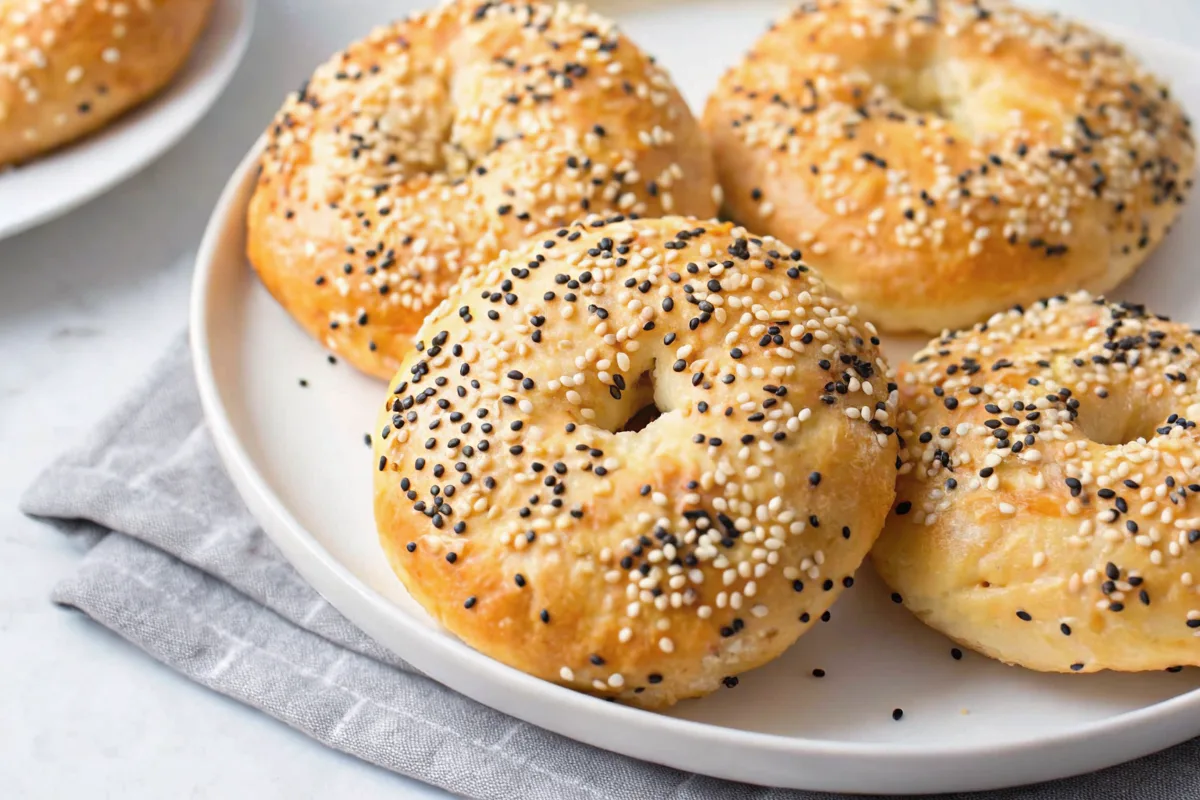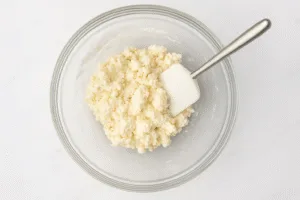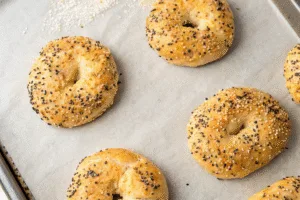High protein bagels are a quick, healthy alternative to traditional bagels—soft, chewy, and packed with protein. With just three simple ingredients and no yeast required, they’re perfect for busy mornings, post-workout meals, or anyone looking to stay fuller longer. In this guide, you’ll find the best ingredients, a step-by-step recipe, nutrition tips, and answers to common questions about these protein-rich bagels.
Table of Contents
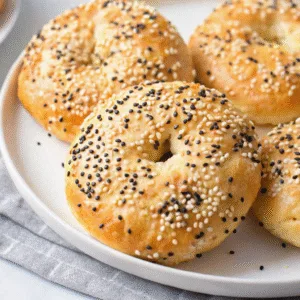
High Protein Cottage Cheese Bagels
Ingredients
- 1 cup full-fat cottage cheese blended and strained
- 1 cup self-rising flour or use AP flour with baking powder
- 1 egg for egg wash
- Everything Bagel seasoning optional
Instructions
- Preheat oven to 375°F and line a sheet pan with parchment paper.
- Blend cottage cheese until smooth and transfer to a mixing bowl.

- Add flour and mix into a sticky dough. Add more flour if needed.
- Knead lightly, divide into 4 balls, and shape each into a bagel.

- Brush with egg wash and top with seasoning if desired.

- Bake for 25–28 minutes until golden. Cool 10 minutes before slicing.

Notes
What Makes a Bagel High in Protein?
Protein-Rich Ingredients to Look For
When it comes to high protein bagels, it all starts with smart ingredients. Traditional bagels are primarily refined flour, offering plenty of carbs but little in the way of protein. To build a better bagel, swap out or supplement those carbs with ingredients that naturally deliver protein.
Blended cottage cheese is one of the best choices. It’s mild in flavor and blends smoothly into dough, providing structure and a creamy texture. One cup of full-fat cottage cheese can deliver 25g of protein on its own. You can also use Greek yogurt, which adds tang and boosts protein while maintaining a light, fluffy crumb.
Other popular protein boosters include:
- Almond flour (high in plant-based protein and gluten-free)
- Eggs (great for binding and enriching the dough)
- Whey or plant-based protein powders (for customized macros)
- Whole wheat flour (higher in protein and fiber than all-purpose)
Incorporating these ingredients not only amps up the protein but also improves the overall nutritional profile of your bagels. They become more satisfying, especially for breakfast when a protein-rich meal can set the tone for balanced energy all day long.
Traditional vs. High Protein Bagels
Let’s compare a standard store-bought bagel with a homemade high protein version:
| Type | Calories | Protein | Carbs |
|---|---|---|---|
| Traditional Bagel | 260–300 kcal | 8–10g | 50–55g |
| Cottage Cheese Bagel | 180 kcal | 11g | 25g |
The difference is clear. By switching to homemade high protein bagels like the ones in our cottage cheese bagel recipe, you slash carbs, reduce calories, and almost double the protein—all without sacrificing flavor or texture.
How to Make High Protein Bagels at Home
Cottage Cheese as a Secret Weapon
Cottage cheese might not be the first ingredient that comes to mind for a bagel—but once you try it, you’ll never look back. It blends easily into the dough, creating a soft texture while quietly adding a protein boost. One cup of full-fat cottage cheese brings around 25g of protein to the mix, making it the star of this simple yet powerful recipe.
Blending it first helps achieve a smooth, lump-free texture that mimics the consistency of traditional dough. For those with texture sensitivities or picky eaters, this trick makes a world of difference. Strain it first if there’s too much liquid, and feel free to use 2% or even low-fat versions—they still bake up beautifully.
Cottage cheese doesn’t overpower the flavor, so the bagels stay neutral and pair well with sweet or savory toppings. You can customize them easily with Everything Bagel seasoning, sesame seeds, or even cinnamon for a sweet variation.
Step-by-Step Recipe Overview
Let’s walk through exactly how to make your own high protein bagels at home in under 30 minutes.
Ingredients:
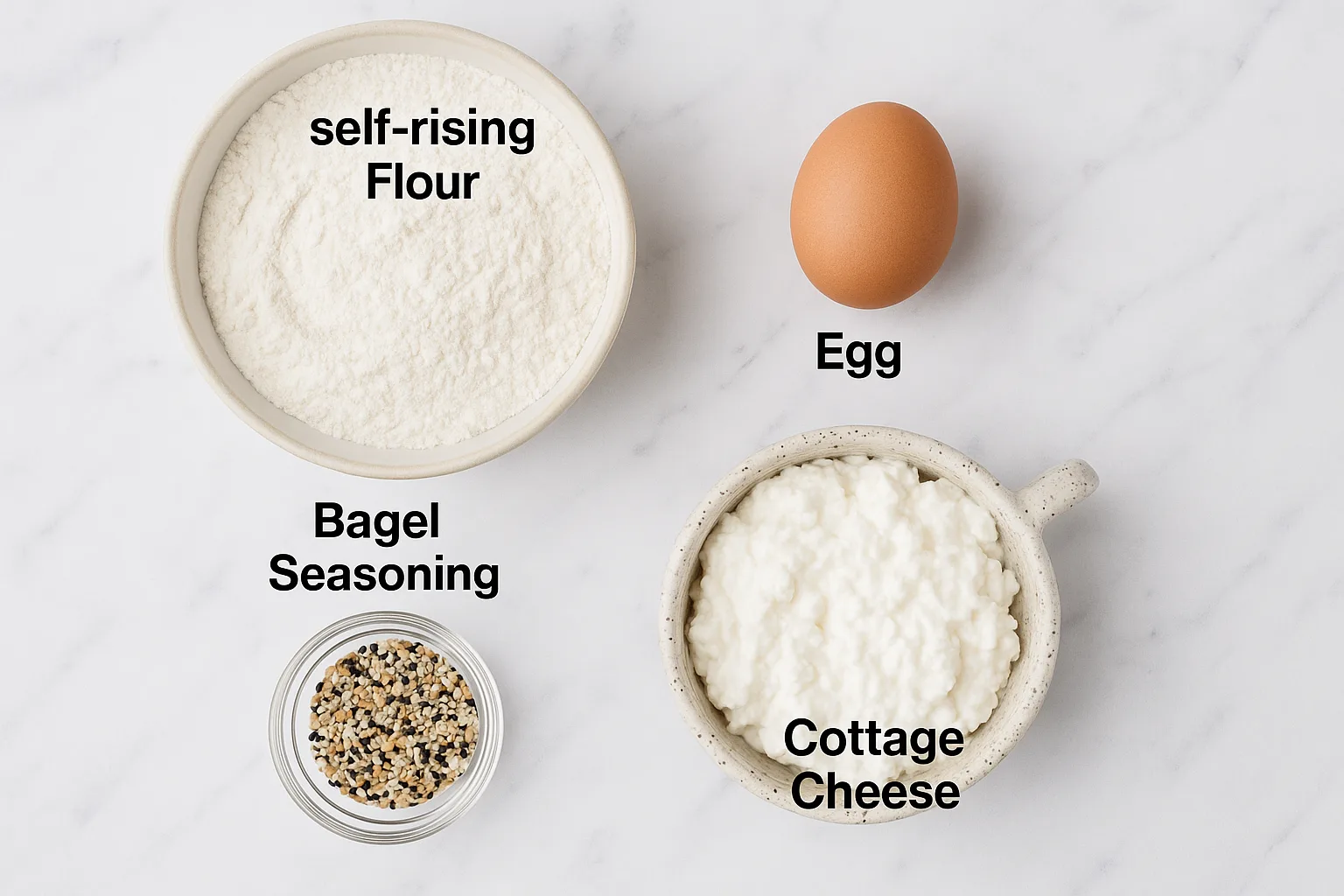
- 1 cup full-fat or 2% cottage cheese, strained and blended
- 1 cup self-rising flour (or all-purpose with baking powder + salt)
- 1 egg (for egg wash)
- Everything Bagel seasoning or sesame seeds (optional)
This recipe is perfect for busy mornings, especially when you’re aiming for something hearty but wholesome. And the simplicity is key—no yeast, no waiting to rise, just quick homemade goodness.
Looking for other easy, customizable baked goods? Try our bento cake recipe for a fun, mini dessert option that pairs beautifully with your morning coffee after a bagel breakfast.
Ways to Add More Protein to Bagels
Smart Add-ins and Swaps
If you’ve mastered the basic cottage cheese bagel, it’s time to take it up a notch. One of the easiest ways to increase protein is by tweaking the dough with add-ins that offer more than just structure—they pack serious nutritional value too.
Here are some easy swaps and mix-ins to try:
- Greek yogurt: Swap in part or all of the cottage cheese with thick Greek yogurt (especially the 2% or full-fat variety). It adds tang and a dense dose of protein.
- Protein powder: Stir in a scoop (about 2 tablespoons) of unflavored or vanilla whey protein for an added 8–10g per batch. Just reduce the flour slightly to keep the dough workable.
- Egg whites: Mix in a couple of tablespoons of whipped egg whites for extra moisture and lean protein. You’ll also get a fluffier crumb.
These additions blend seamlessly into the dough and can make your bagel go from 11g of protein to 15g or more—perfect for fitness-conscious eaters or anyone trying to stay fuller longer. And remember, quality ingredients mean better flavor and nutrition.
High Protein Toppings & Fillings
The dough isn’t the only place to get creative. What you put on or inside your bagel can dramatically boost its protein content—and make it even more satisfying.
Try these protein-packed pairings:
- Smoked salmon + light cream cheese
- Mashed avocado + poached egg
- Turkey breast + hummus
- Cottage cheese + cherry tomatoes
- Egg + cheddar + spinach (breakfast sandwich style)
One of my family’s favorites is using a freshly baked bagel as the base for a warm breakfast sandwich. Scrambled eggs and turkey bacon between two bagel halves? That’s over 25g of protein in one grab-and-go meal.
Even sweet combinations work. Think almond butter and banana, or Greek yogurt with berries. It’s all about balance—and delicious nutrition.
These topping strategies are also great for using leftover bagels creatively. Store extra in the freezer and toast them for fast weekday meals. If you’re looking to pair these with a sweet-but-light treat, our mini bento cake recipe adds a touch of joy without overpowering your macros.
Are High Protein Bagels Really Healthy?
Nutritional Benefits Explained
Yes, high protein bagels can absolutely be a healthy choice—especially compared to traditional store-bought versions that are high in refined carbs and low in fiber or protein.
Here’s what makes these bagels a better-for-you option:
- Higher satiety: Protein helps you feel full longer, reducing the chance of mid-morning snacking.
- Muscle support: It aids muscle repair and maintenance, making it a great post-workout breakfast.
- Balanced energy: Fewer blood sugar spikes, thanks to protein slowing down carb absorption.
Take our cottage cheese bagels, for example. Each serving has:
- 180 calories
- 11g protein
- Just 25g of carbs
- Only 4g fat
That’s a well-balanced start to your day and far lighter than most bakery bagels, which can top 300 calories with barely 8g of protein.
You also avoid artificial additives, preservatives, and excess sodium found in store-bought versions. When you bake at home, you control the ingredients and the outcome.
Pairing one of these bagels with toppings like eggs, lean meat, or nut butter easily pushes the protein content to 20g+—the sweet spot for breakfast, according to most nutritionists.
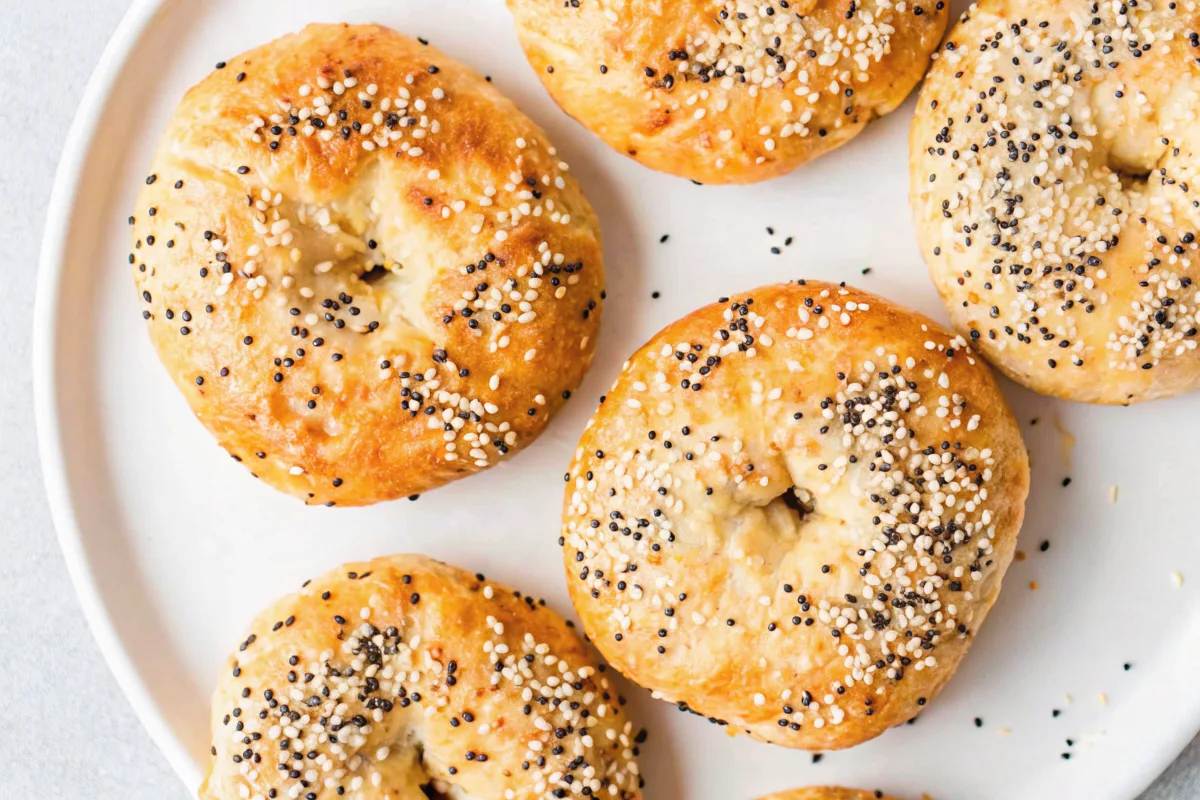
Comparing Store-Bought vs. Homemade
Most store-bought bagels labeled as “high protein” come with trade-offs: added gluten, soy isolates, and preservatives to enhance shelf life or texture. While they may advertise 12–15g of protein, they often include unnecessary fillers.
In contrast, homemade bagels like ours use real, whole ingredients: cottage cheese, flour, and egg. They deliver protein naturally—no weird additives, no surprises. And they’re surprisingly quick to make.
If you want the control, freshness, and satisfaction of knowing exactly what’s in your food, this bento cake recipe follows the same home-baked, better-for-you philosophy—delicious, minimal, and made with love.
FAQs
Which bagels are high in protein?
High protein bagels are typically made with ingredients like cottage cheese, Greek yogurt, almond flour, or added protein powder. Look for brands or recipes with at least 10g of protein per serving. Homemade options using dairy-based proteins are often the cleanest.
How to add more protein to bagels?
Add protein-rich ingredients directly into the dough—like cottage cheese or protein powder—or top the finished bagels with eggs, meats, hummus, or nut butters. You can also pair with high protein spreads or fillings to enhance the macros.
Are high protein bagels healthy?
They are much healthier than regular bagels when made with simple ingredients and no refined sugars or fillers. Higher protein content leads to better blood sugar control, longer-lasting energy, and improved satiety.
How much protein is in a cottage cheese bagel?
Each bagel made from this recipe has approximately 11g of protein. Add an egg or some smoked salmon, and you can easily reach 20g+ per serving, making it a powerful meal option.
High protein bagels are a simple, satisfying way to enjoy a classic comfort food—without the carb overload. By using ingredients like cottage cheese and self-rising flour, you can whip them up in under 30 minutes with minimal effort and big nutritional payoff.
They freeze beautifully, toast up perfectly, and can be topped with anything from avocado to almond butter. Whether you’re feeding kids, meal prepping for the week, or just craving something warm and wholesome, these bagels deliver every time.
So the next time you’re tempted by the bakery aisle, skip the empty carbs and make your own instead. Your body (and your taste buds) will thank you.
And for a perfectly portioned dessert to follow? You’ll love our What is a bento cake post—it’s the ideal way to add a little sweetness after all that savory goodness
Want more creative recipes like this? Follow us on Facebook and Pinterest for daily recipe inspiration!
